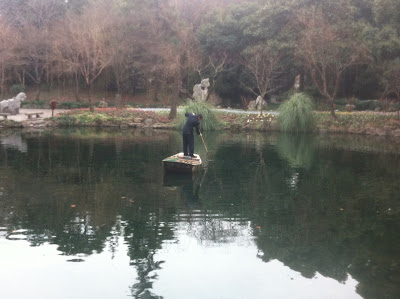The garden is comprised of several acres of delicate ponds, still-green-in-winter grassy areas, and jagged, jarring rock formations. The telltale sights and sounds of the construction that is still pervasive, even some 20 kilometers away from downtown Shanghai, are still present, providing ample point counterpoint opportunities for the contemplative photographer. But it feels like an oasis, a taste of the old amidst a desert of new.
The garden was constructed in the early Ming Dynasty (16th Century) as an homage to the emperor at the time (very common). It's been moved and rebuilt several times, but unlike the more-famous Yu Garden (豫园), it hasn't been overrun by the expat-targeting tourist trap shops, merchants, and overpriced food purveyors. Instead, the tourist appeal at Guyi is distinctly Chinese - there were plenty of people here, but I failed to see a single fellow Westerner during my afternoon there.


The garden attracts visitors as well for the restaurant that abuts it -- The Guyi Garden Restaurant, which purports to have been the original source of the now-famous Shanghai xiaolongbao soup dumplings (小笼包). The restaurant has been churning out the fluffy, fat-filled fancies since 1871, if the sign out front is to be believed. A brief disclaimer -- like pizza and hamburgers in New York, the battle to be known as the progenitor of the xiaolongbao is not a cut and dry case. Many places claim to have initiated the soup dumpling tradition, that is now not even solely associated with Shanghai, but rather for much of this east-central region of the country. In fact, Guyi doesn't even refer to its wares as Shanghai xialongbao, but rather Nanxiang xiaolongbao. I've seen similar turf declarations in Nanjing and Suzhou as well.
Regardless of who started making soup dumplings, I ordered a basic set of dumplings to see whether the quality mirrored the longevity. Inexplicably, the smallest order of xiaolong had 25 pieces, so I must sheepishly admit that I was unable to finish (remember, I'm not feeling well, and these things don't exactly have the same recuperative powers of Mom's chicken soup, so give me a break). The dumplings were quite tasty, and the vinegar and lajiang (辣酱, the red hot sauce), both shown below, were excellent. Everything was far better than what you could get at a random street vendor, but perhaps not quite as delightful as some of the fancier, famous places downtown (e.g. Din Tai Fung, Crystal Jade, etc). Then again, of course, those joints serve about 4-6 soup pouches for the same price that I paid for my 25. So there.
Shanghai is not a famously beautiful city. It is also not famous for its spectacular tourist attractions. While it does have a fascinating history, most of that history is invisible now -- the city today is only about 30 years old, and was built on top of the various prior renderings of Shanghai. It has a ton of things going for it, but these three things are probably not its strongest assets. But in a city so massive, with just a little digging, you can find nuggets of both history and beauty, well within the city limits. Less than two years ago, Nanxiang wasn't accessible by Metro. Now it is. As I made the trip up, which took far less time than it would take me to get from the Upper West Side to Coney Island, I noticed unfamiliar colors and shapes sprouting in unfamiliar directions on what had become an entirely familiar Metro map. As the city expands, so too is the Metro -- four brand new lines are either set to open or have done so already. Without any fanfare or hoopla, the Metro expanded, virtually overnight, presumably opening up easy access to far more hidden Nanxiangs.
It's a bit hard to read, but this one says, "Green will benefit ones's health."
This last one isn't even from today - it's from a few nights ago at a new whiskey bar that opened up downtown. What you're looking at is a glass of Glenfiddich 15 year single malt scotch, at a shockingly reasonable price for downtown Shanghai (or anywhere). I quickly discovered why it was so cheap -- they don't give you very much scotch and instead filled the tumbler with an ice cube the size of Neptune. Rookie mistake on my part, particularly considering you should never drink single malt with ice.









No comments:
Post a Comment